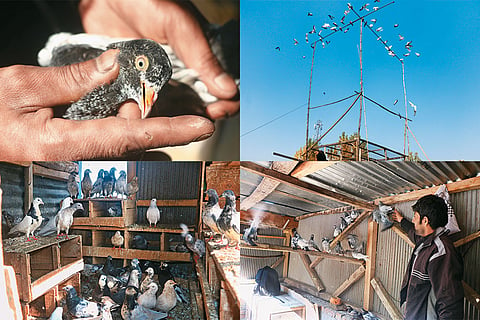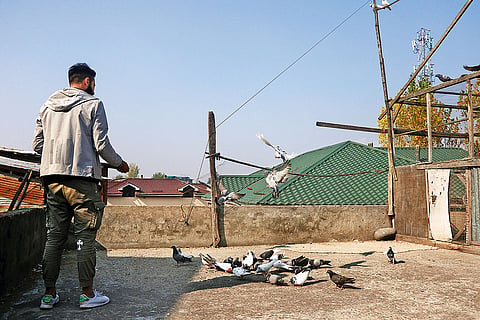Palhalan, Baramulla, north Kashmir. Once a hotbed of separatist militancy, people of the area are in the throes of a new fancy these days—pigeon breeding. Ghulam Ahmad Sheikh, 45, stands on the open roof of his modest house in Tantray mohalla, a big smile on his face. In his hands he holds a common rock pigeon. “My name is Ghulam Ahmad Sheikh, but in our locality, I’m better known as kotur (pigeon).”
Kashmir: In The Valley, Pigeons Give Youths Wings To Embrace Peace
Pigeon rearing has become among Kashmiri youth and for some, it is financially rewarding as well.
On one corner of the roof of the pigeon fancier’s modest house is a coop. Next to it, two bags of paddy and maize for the pigeons. “I’ve been petting pigeons since childhood. I can’t imagine life without them,” says Ghulam, as he enters the coop to bring out two newly-hatched squabs. “Tell me which one is male, and which is female?” he asks rhetorically. “These pigeons are of Parsaifd Lutsaifd (white feather and white tail) variety. Look at this one, with a long beak and big head. It’s male. Now look at this one with a short beak and small head. It’s female,” he answers himself.
The babies, he says, are born with eyes closed. The nestling’s eyes open after 4-5 days, he adds, as he returns the babies to the coop. Ghulam’s father, Muhammad Sheikh, was a farmer, and also a devoted pigeon fancier, as was his grandfather Rehman. “Now my son Yaseen Ahmad Sheikh, a student of Class VI in a private school, is taking care of his pigeons. He feeds them twice a day,” says the proud father.
In earlier times, when most households of Palhalan kept pigeons, bird racing was a regular affair. But now, racing is no longer in vogue, says Ghulam, attributing the change to the high price of different breeds, and difficulty in rearing them.

Ghulam Ahmed Sheikh with his pets
Taking care of pigeons is not an easy job, especially when they get sick. “Some of them get wajj (paralysis). Another common ailment is skin disease and fungal infection, which affects their eyes and mouth. At times, even the fancier gets infected, he says.
When a pigeon gets ill, fanciers in the area don’t go to a vet. They have local remedies for these diseases. “If a pigeon suffers from skin disease, I first isolate it, then massage its ‘pimples’ with hot oil, till they become hard, when I can remove them. The pigeon usually recovers within a few days,” says Ghulam. In case of a paralytic attack, he massages the stricken bird with hot oil and gives it Vimeral syrup, a supplement for poultry. If the bird survives for about four days, it’s considered to have recovered.
Unlike traditional fanciers, most breeders in Srinagar prefer vaccination and other modern methods to treat their ailing pets.
Ghulam’s house was once surrounded by poplars, before he insisted upon his neighbours to fell them, with the excuse that they were posing a danger to his house. “Actually, I was least bothered about my house. I was concerned about my pigeons, as the poplars confused them on their flight home,” he says, laughing at his ingenuity.
Each pigeon pair produces around 11 pairs of squabs a year. “That is the norm I have observed over the years. But since cellphone towers came up in our villages, I feel they are not reproducing as much. It looks like the towers have impacted their reproductive cycle,” he says. Ghulam argues the towers are behind deaths and disappearances of many other bird species, such as the sparrow. “Earlier, in our village, you would see a lot of sparrows, but now you won’t see too many. I think mobile towers are the culprit,” he adds.
As Ghulam speaks, curious neighbours gather to watch him from their windows. Some 30 years ago, pigeon fanciers of the area had only a few breeds with them. Now, they have many, including rare, expensive varieties.
During the Valley’s long and harsh winters, pigeons prefer to remain inside their coops. Ghulam says even breeders prefer to keep their pets inside coops, as they face a threat from falcons hovering above. The coop is kept warm, while gaps in its walls are covered up with polythene. “In summers, pigeons are kings of the skies,” Ghulam says, adding this is because then, swarms of a local variety of swallow called katij go after the falcons, keeping the pigeons safe.

Feathered friends (clockwise) Ghulam with a squab; birds perched on a raised loft; inside a coop in Anantnag; Inside Ghulam’s coop
Ghulam points to a pigeon and says it is called Basewozul. “It is white all over, with wozul (red) colour around its stomach.” Pointing to another pigeon, he says, bashfully, “It’s called Wudwun (one that flies), as it can fly for long hours.” Another one, with a black eye and a red eye, called Tajal-ul- Mozal, is one of the costliest breeds. An Iranian Tajal-ul-Mozal costs around Rs 40,000-50,000, he says.
Mohammad Humayun Bhat, who lives in south Kashmir’s Pulwama district, says falcons don’t venture out during peak summer—June to August—so that’s when pigeon racing tournaments are held. Fanciers choose pigeons that fly well, and the bird that flies for the longest time wins. Bhat, a graduate in hotel management and hospitality, has around 300 pigeons in his loft.

A pigeon fancier
According to Bhat, the finest pigeon breed at present is called Teddy, also in the Rs 45,000-Rs 50,000 range. It is an imported Pakistani breed with crème eyes and is known to fly very fast. Bhat says the breed was identified by Ustaad Mistry Din of Sialkot, Pakistan. In his spare time, Bhat follows the YouTube channel of Ustaad Ayub of Dubai, to find out more about new breeds. The breed from Sialkot is popular on both sides of Kashmir’s border, and are given catchy names like Pendy Wallay and Ali Wallay.
Around 200m from Ghulam’s house in Palhalan, lives Mohammad Yaqoob Bhat. The local expert on pigeons is pursuing BA from Kashmir University. “I’m not a fancier, but having spent years with breeders, I know both pigeons and their breeders well.” He says fanciers of Palhalan are unabashed about their hobby. “They love it, and don’t see breeding pigeons as beneath their dignity, as people elsewhere seem to do. In fact, during long winters, when they can’t work outdoors, they prefer to spend time discussing new breeds,” he says.
Bhat says, over the years, fanciers have developed certain rules they all stick to nowadays. If a pigeon flies into the coop of another fancier, it belongs to him. Even if a Tajal-ul-Mozal or a Kalewozul—another sought-after breed of white pigeon with red-head—lands within another fancier’s reach, it isn’t returned. In extreme cases, the capturer quickly cuts its flight feathers and hides it in his coop. While some fanciers in the city are also involved in pigeon racing, those of Palhalan focus solely on breeding, as for most of them it’s their livelihood. With pigeon petting and racing a rage in the Valley, even common breeds can fetch around Rs 5,000 to Rs 10,000.
As Ghulam narrates his adventures with pigeon breeding, his wife observes him quietly with admiring eyes. “One day, one of my pigeons didn’t return in the evening. I couldn’t eat, so I left to search for it, and only returned home the next morning,” Ghulam continues. “Some of my best pigeons were lost to predators,” he adds. He says he has wept only once in his life, when a cat killed a dozen birds in his old house. “I felt like someone had stabbed my heart,” he continues.
“Many breeders believe pigeons are spiritual. They bring inexplicable joy and happiness, when you least expect it,” he says, recalling how once, even local militants used to have their pictures taken with pigeons on their shoulders. The messaging was clear—even those who had taken up arms were fighting for peace.
A warp in the space-time of the country without a post office.
(This appeared in the print edition as "Flights of Fancy")
Naseer Ganai in Baramulla and Pulwama